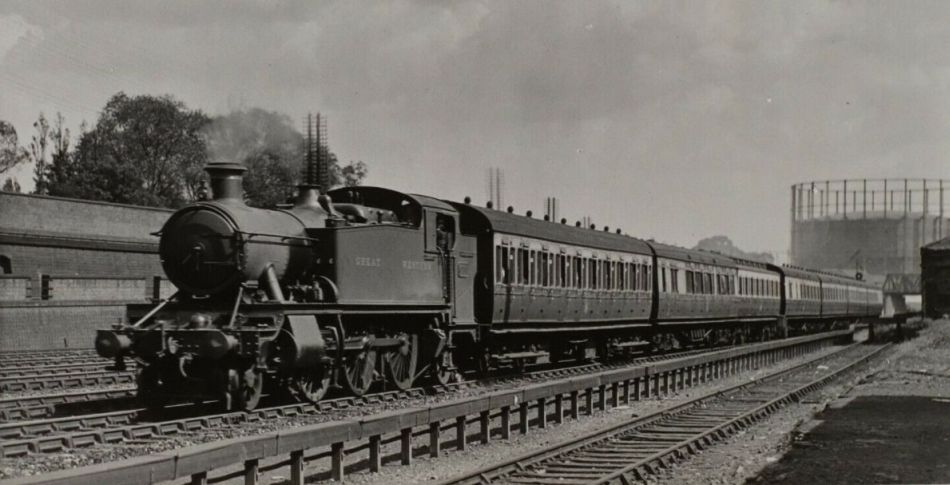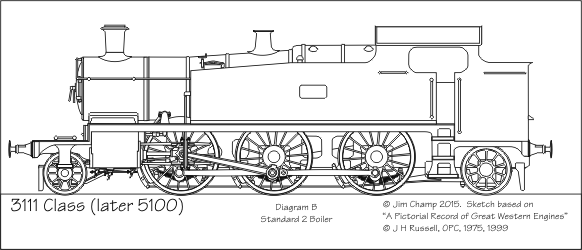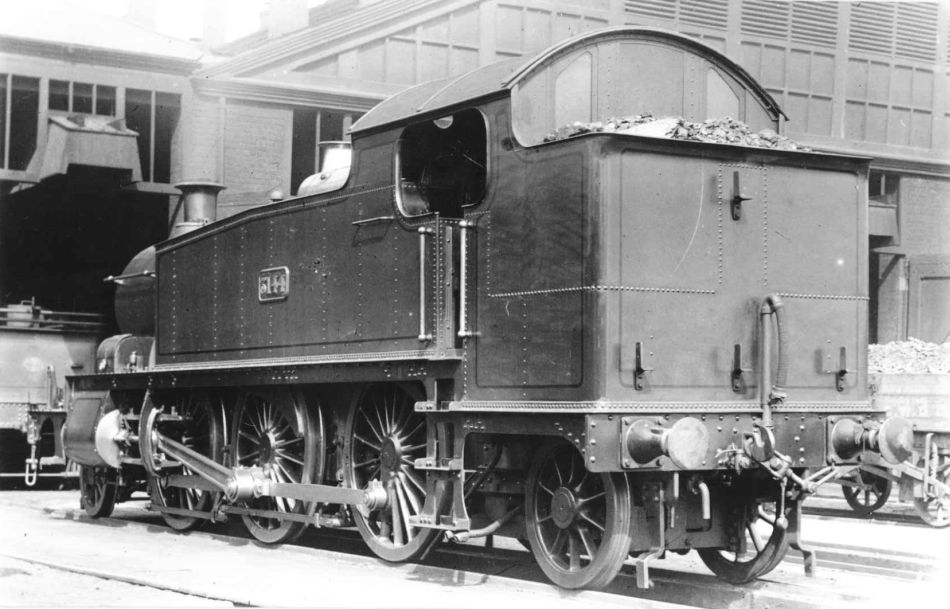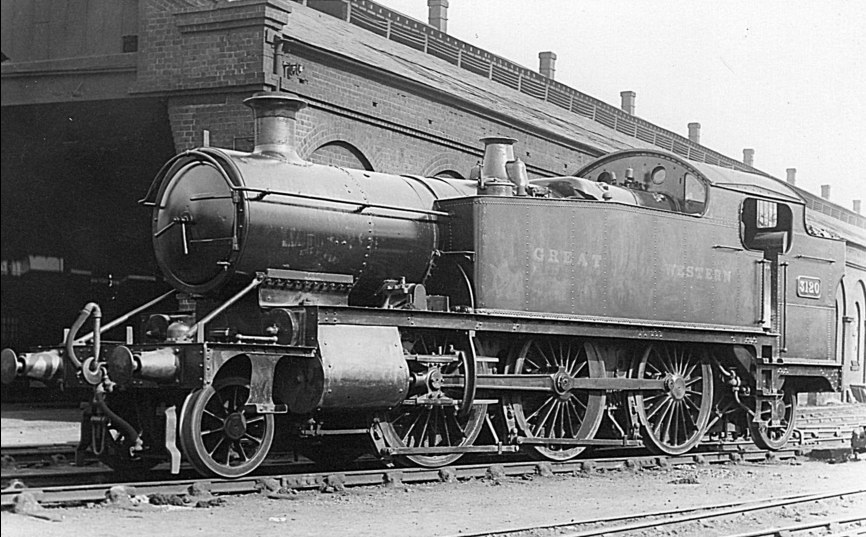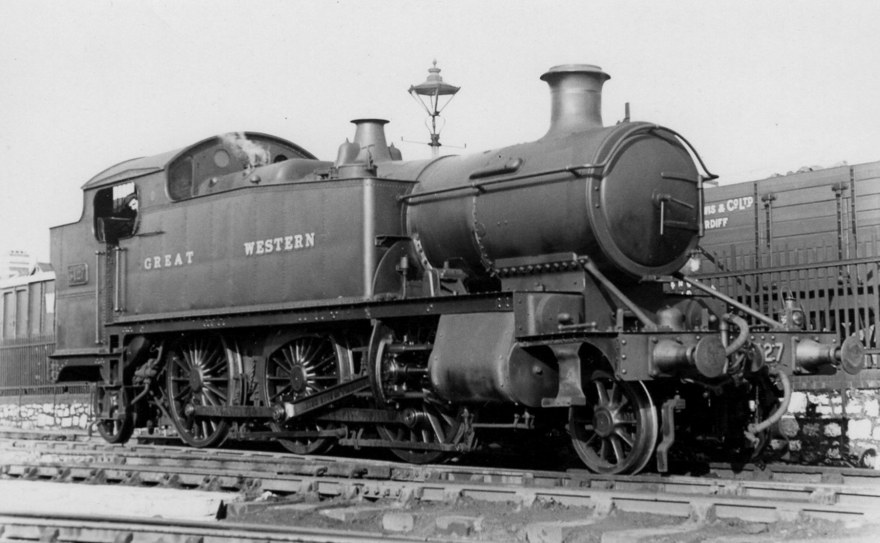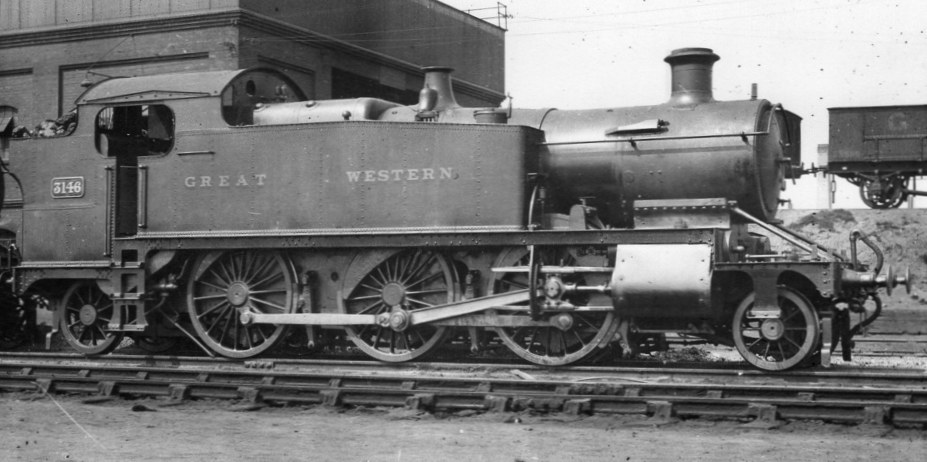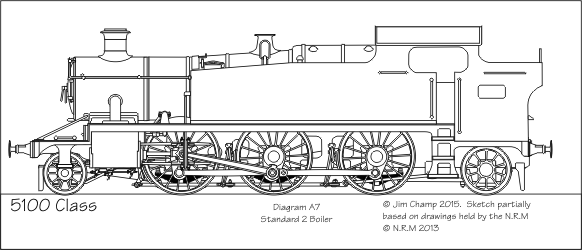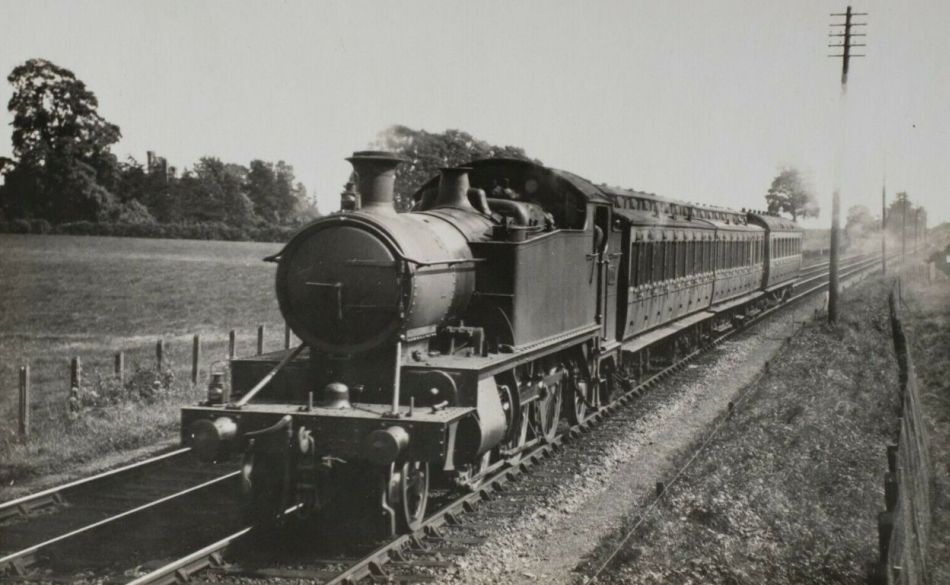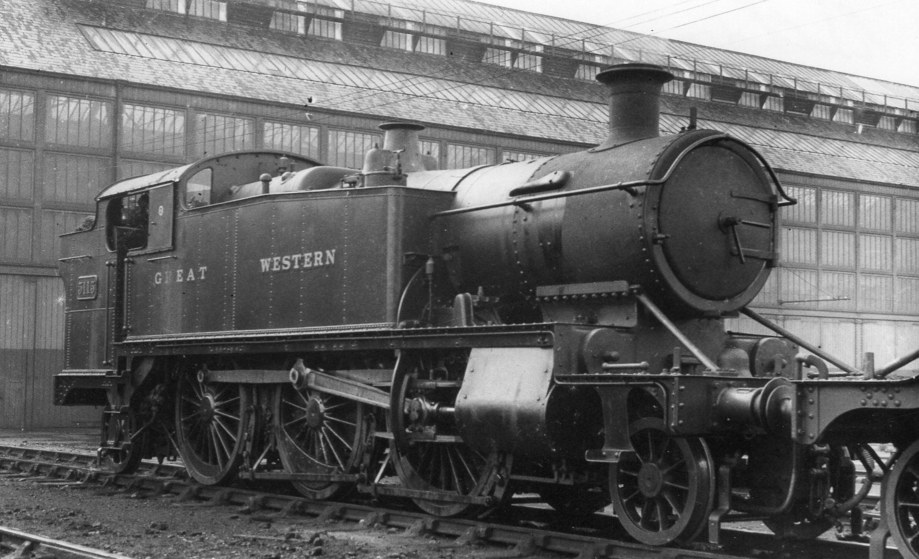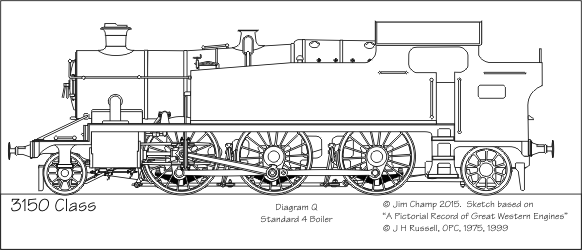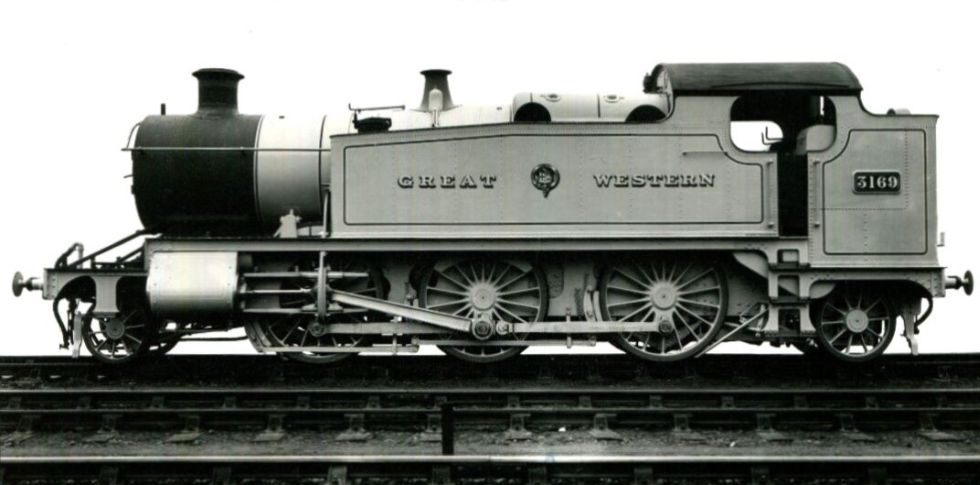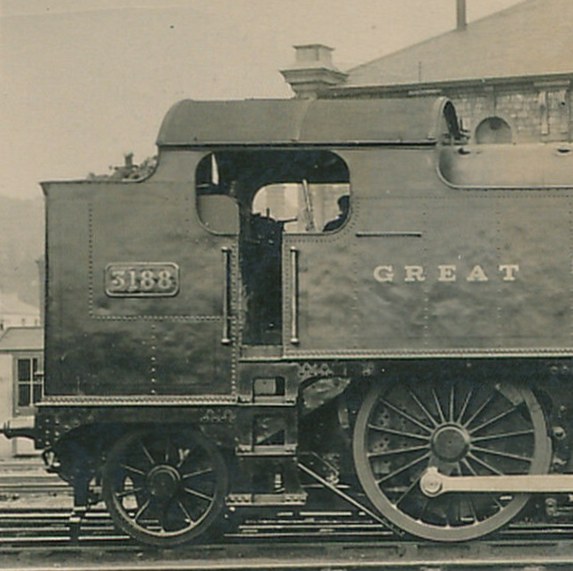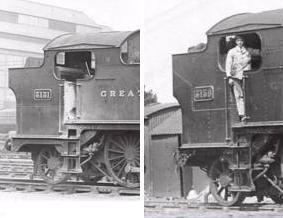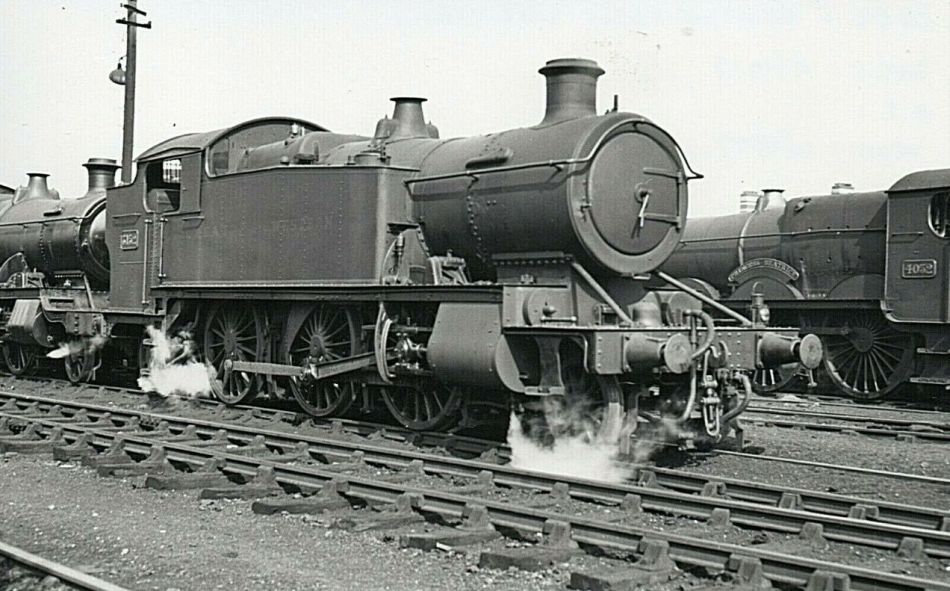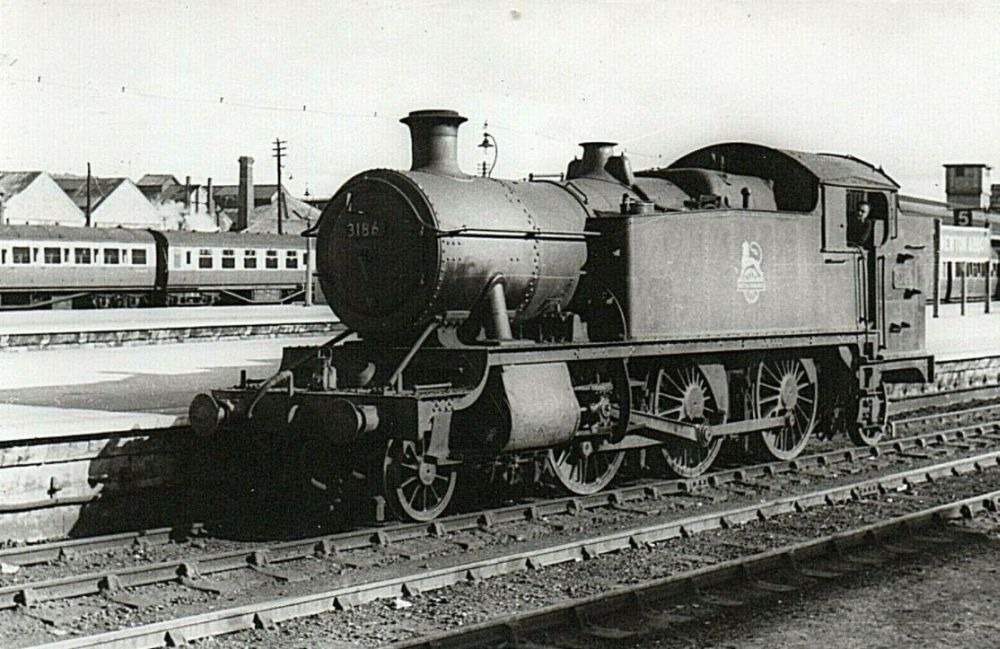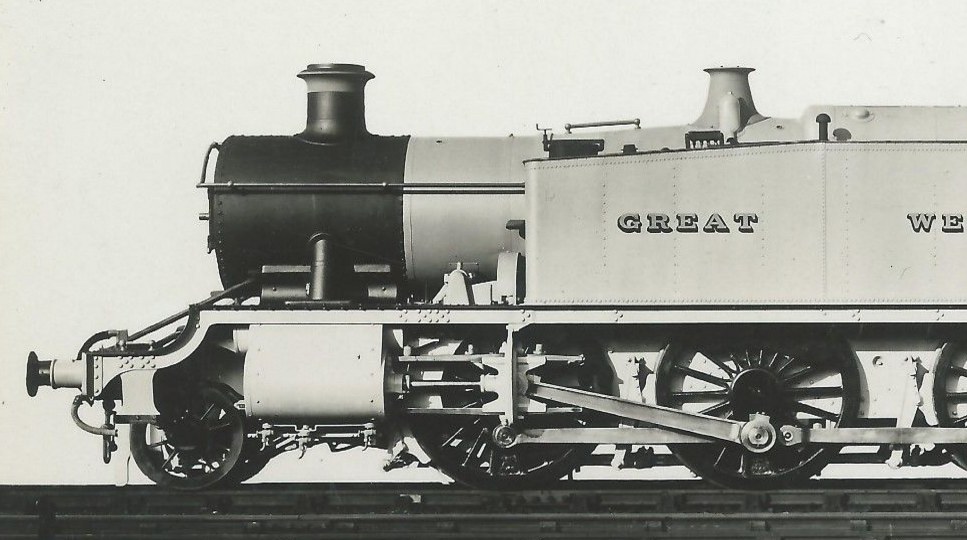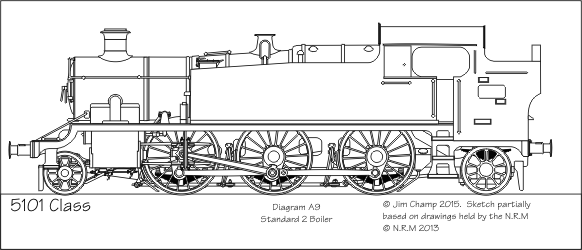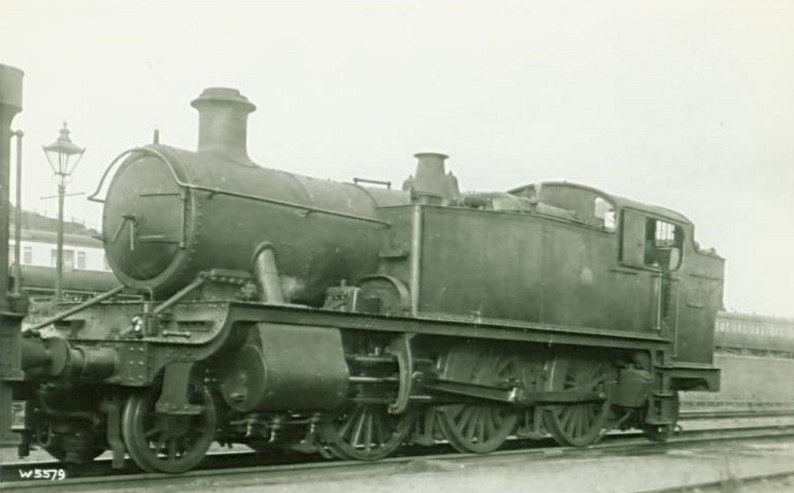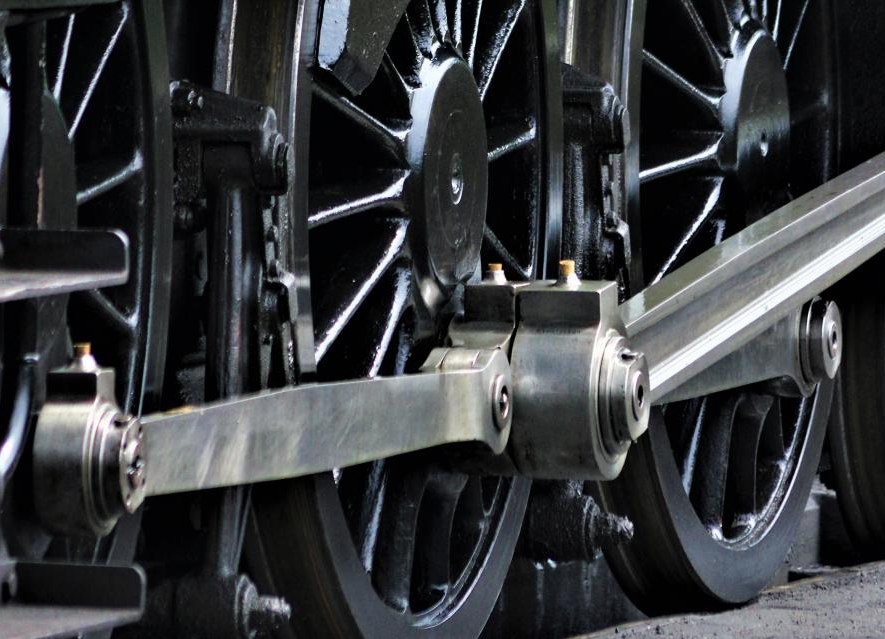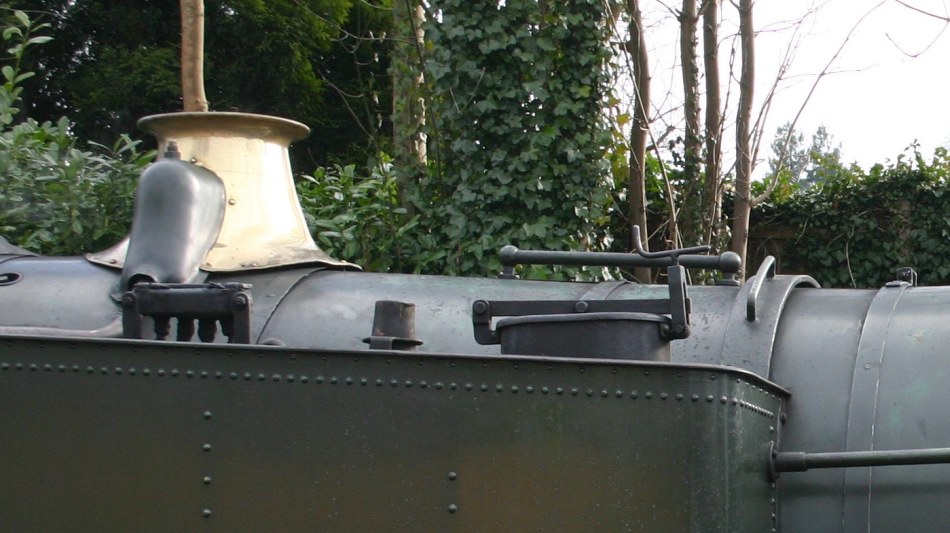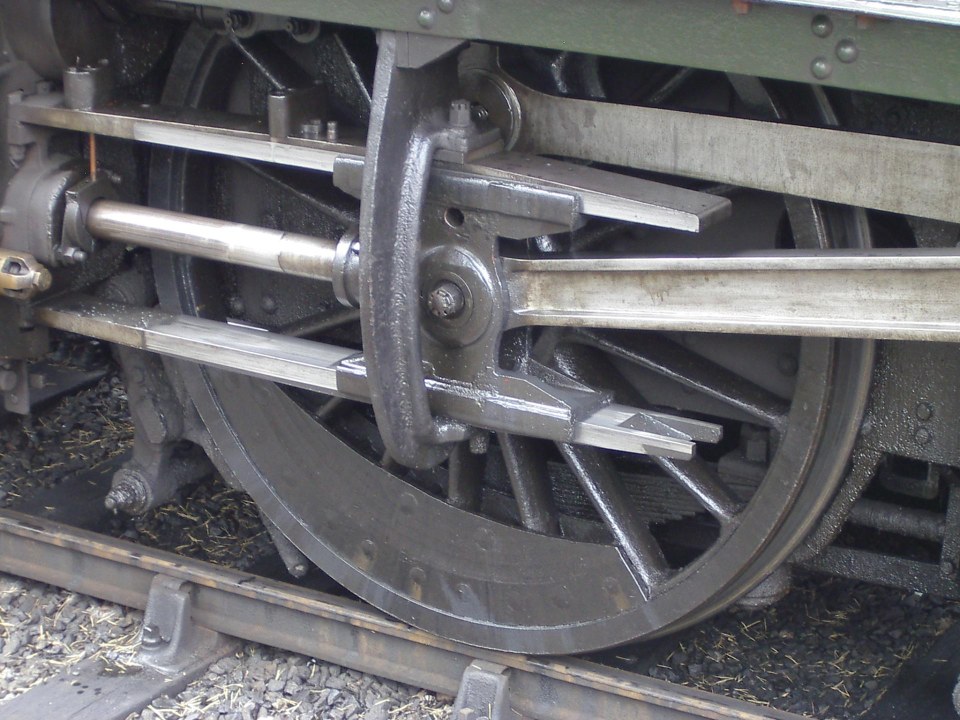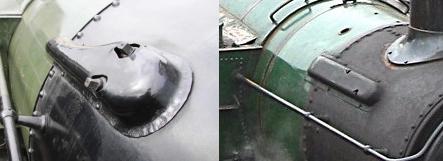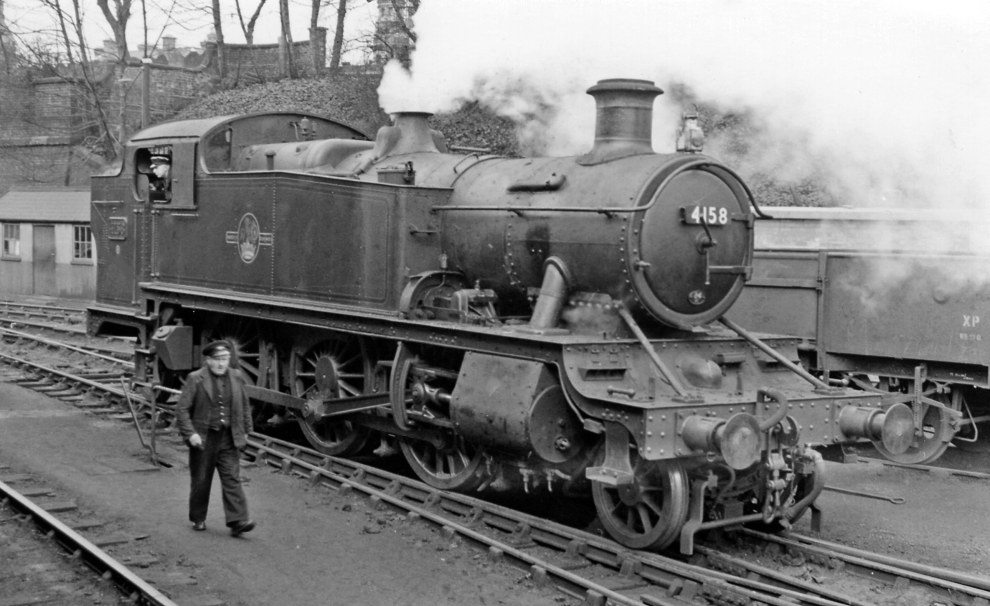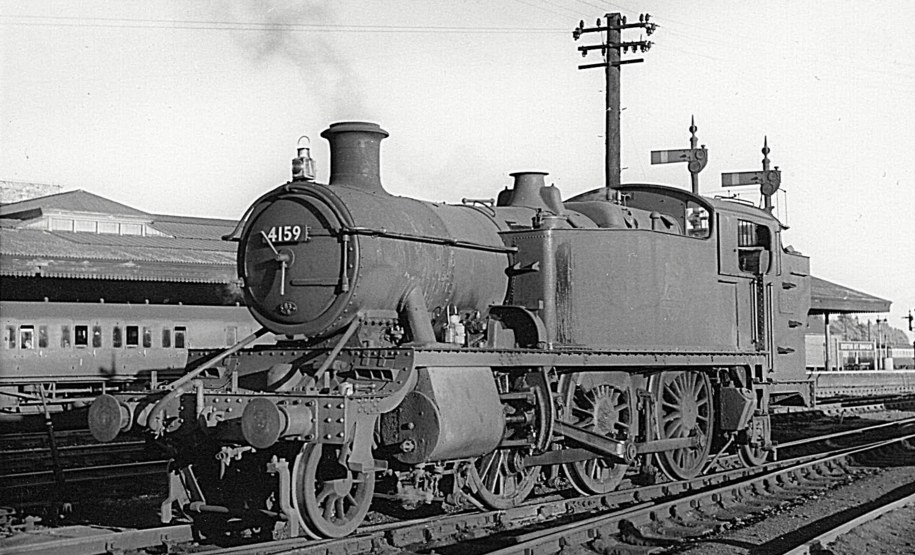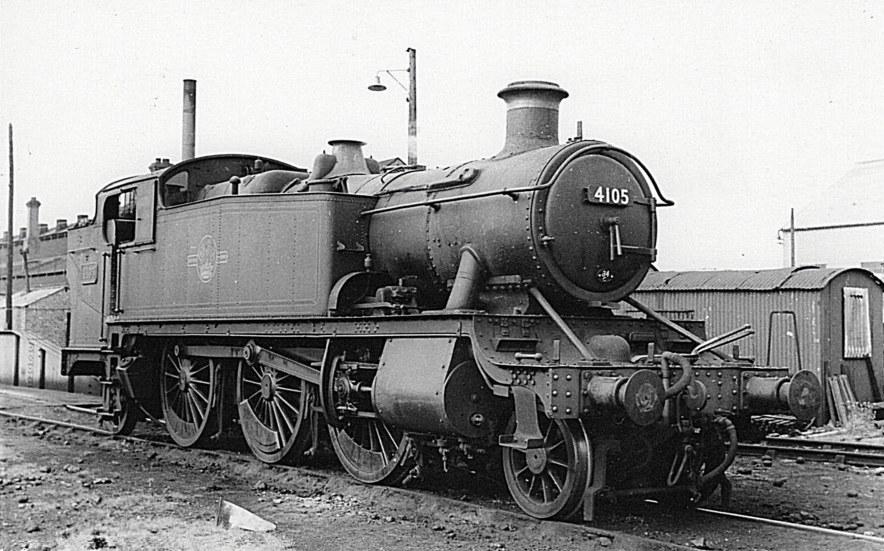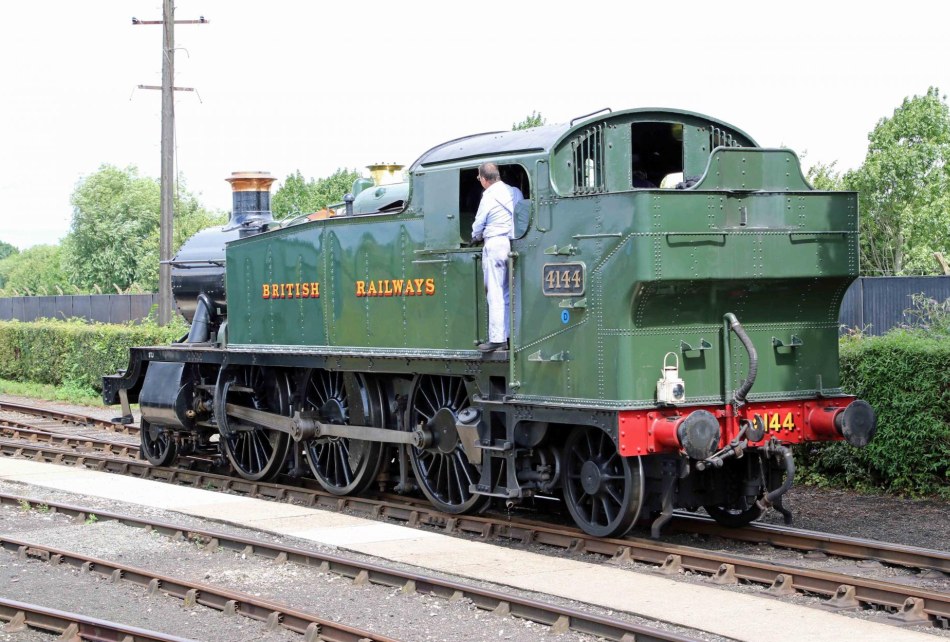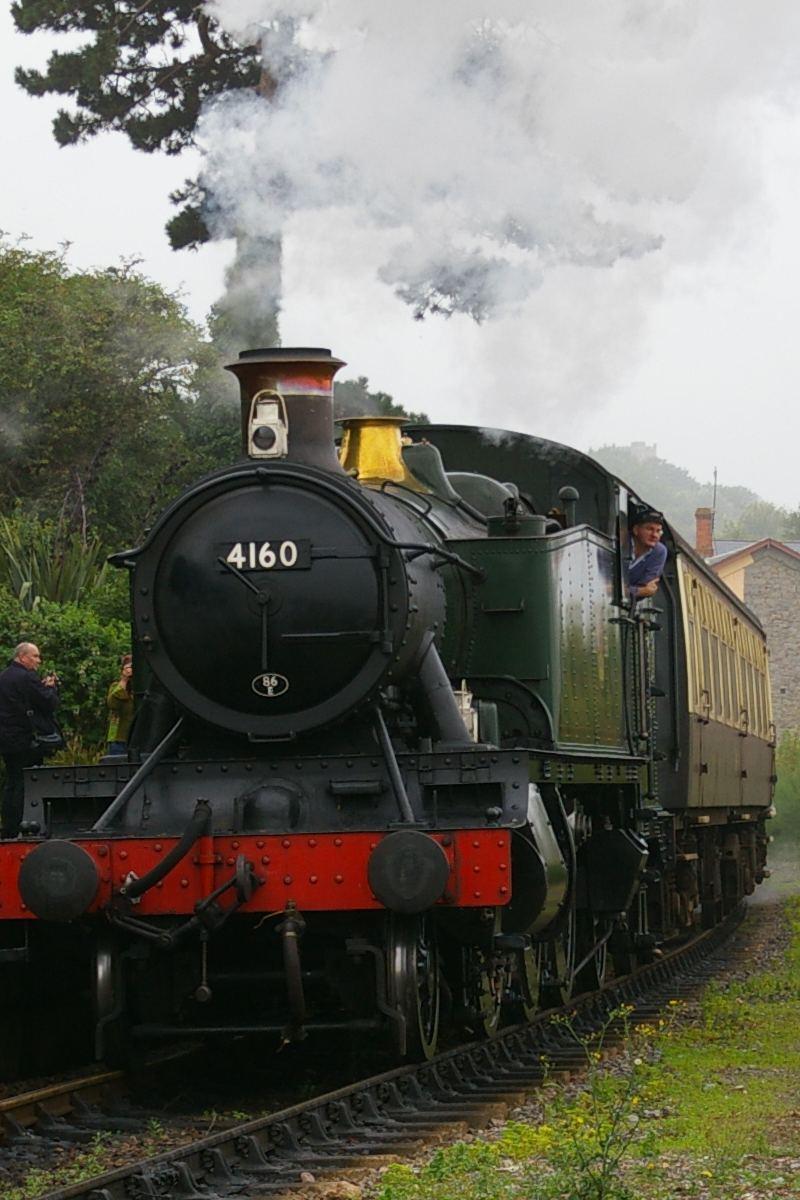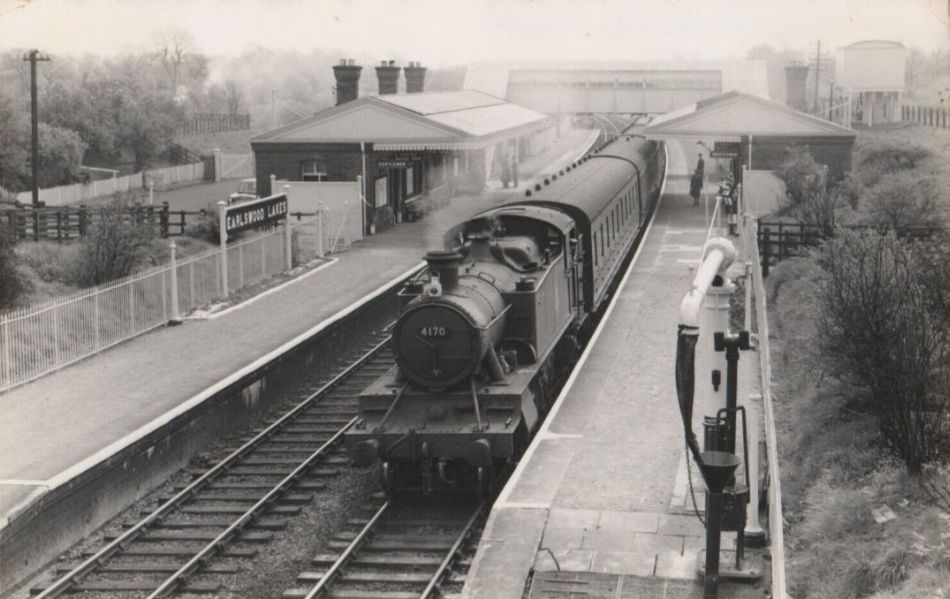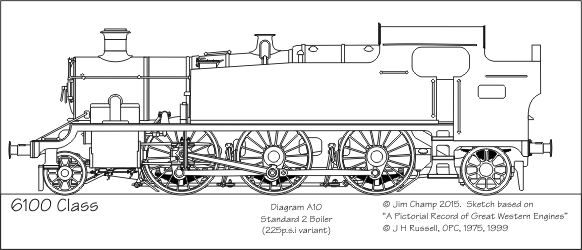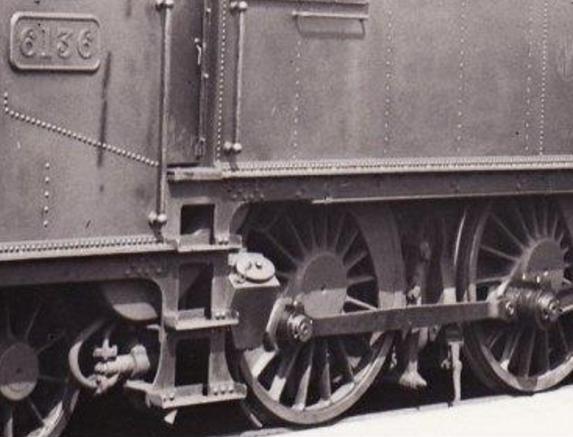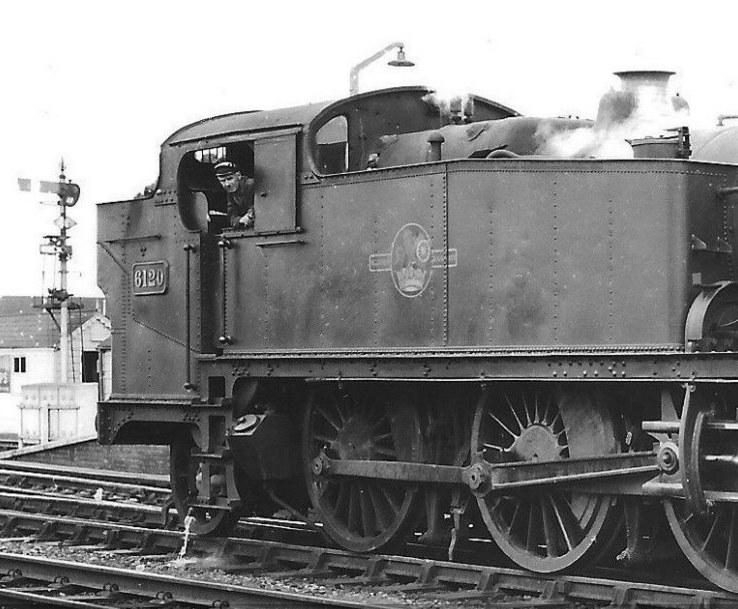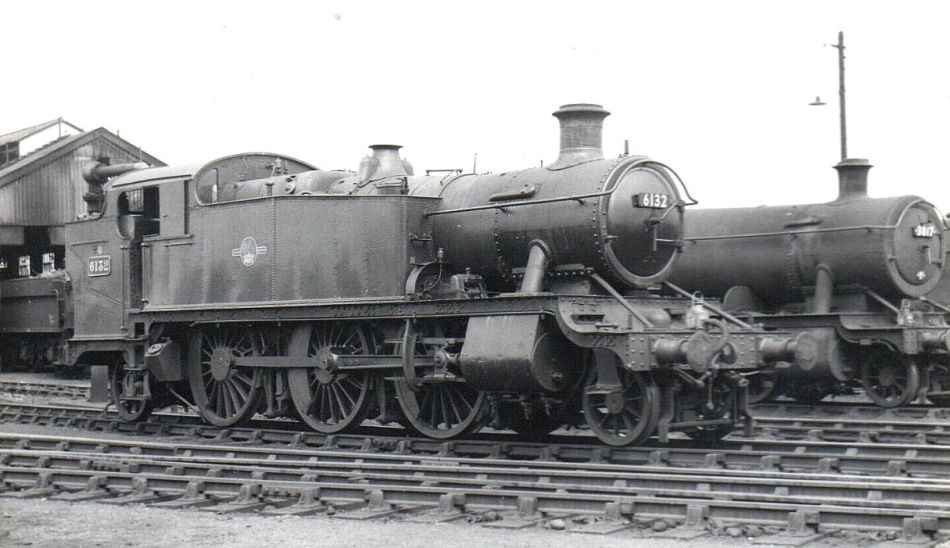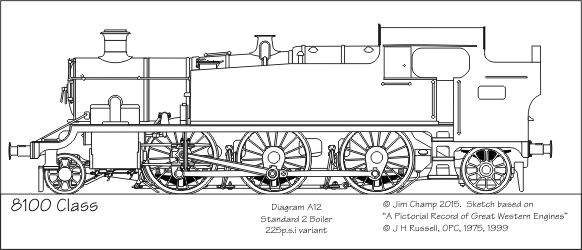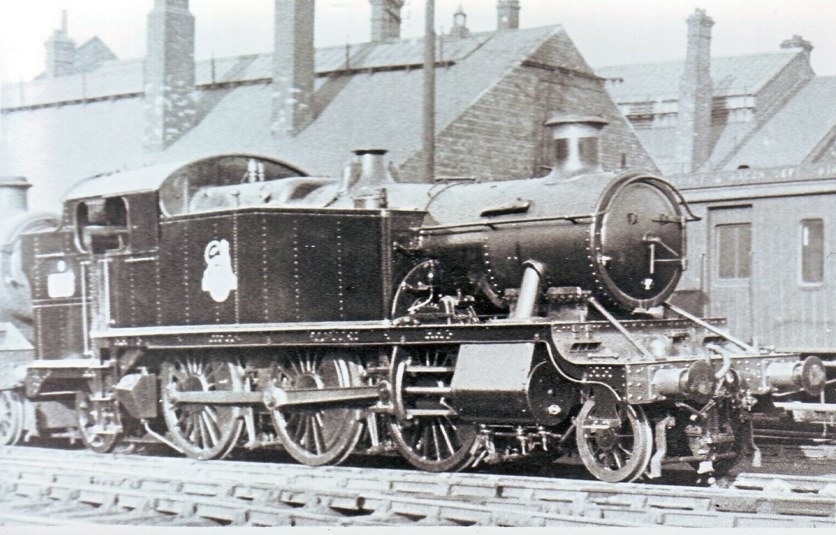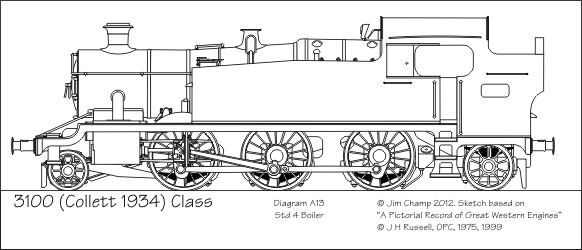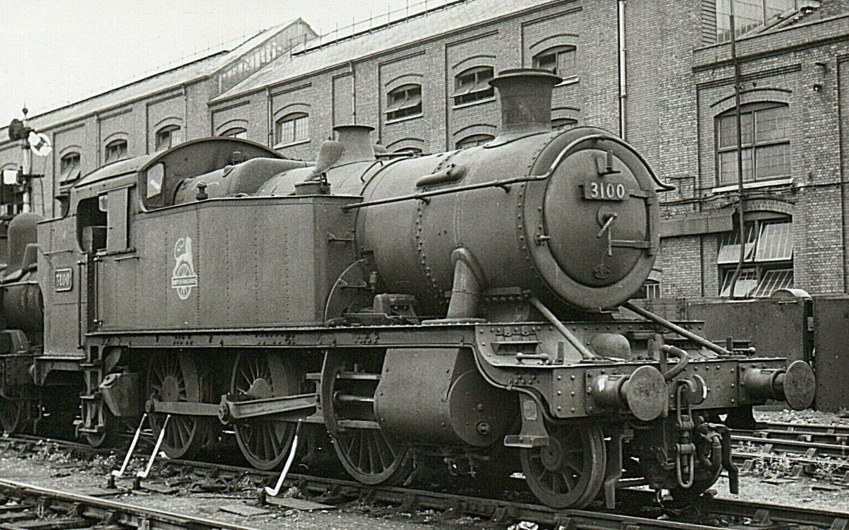| Section Page | Previous Page | Next Page |
A Beginner's Guide to GWR large prairie tanksby Jim Champ(pictures from the webmaster's collection unless otherwise credited)
Introduction The tale of the large prairies is the most complex of the Churchward standard classes, complicated also by renumbering and gaps in the number allocation filled in by later builds. Basically they divide into Standard 2 and Standard 4 boiler variants, with a subdivision into 200psi and 225psi boilers. In the Collett era there were also some variations in wheel size, which seem to have been as much for the accountants' benefit as anything else. K J Cook talks about this in one chapter of his book Swindon Steam 1. What follows here is something of a simplification. The finances of the Railways were strictly controlled by acts of Parliament, and there was a demarcation between capital expenditure and expenditure from revenue. There was also what was called the renewal fund, which was an allocation made out of revenue to replace assets. This meant that in the depression of the late 1920s and early 1930s when revenue was low there was very limited money available for repairs and maintenance. On the other hand there was a healthy amount of money available in the renewal fund for replacement locomotives. This meant that it was easier to find money to replace locomotives than repair them – if what we would now call a business case could be made. The first instance of this was when the last 10 Stars were scrapped and replaced with 10 new Castles. The new Castles, with the exception of cylinders, cabs and boilers, contained a large number of Star parts – including frames – they just happened to have lying around. The 'new' Earl/Dukedog class was an even more extreme example. In the case of the early large Prairies they were getting towards the age when new cylinders and front-end extension frames were going to be required in heavy overhauls. It was decided that it would not be permissible to do this work using the renewals fund and describe the updated locomotives as new. What Collett elected to do was to design new variations of the class with significantly increased power with the intention of using them for roles where the increased power would be valuable. So a new version of the Standard 2 boiler was designed, uprated to 225psi, but with no increase in weight due to the use of high tensile nickel alloy steel and smaller non-standard wheels of two different sizes were used to further increase tractive effort. The result was the new 3100, 6100 and 8100 classes. Tractive effort values given here are nominal figures to the nearest 500lbs, because it is not really a precise measurement: an engine with its cylinders bored out to the wear limit and tyres approaching scrapping thickness might have a theoretical tractive effort getting on for 10% above the nominal figure. However, this was definitely considered in the design of the Large Prairie variants. All the large 2-6-2Ts had spring compensation between the leading pony truck and the leading driving wheels, but they never had compensation between the driving wheels, unlike the Saints and Stars. There was spring compensation between the trailing driving wheels and the rear radial truck on the Churchward large prairies but was absent from Collett build locos and the major rebuilds. This was retained when the 3111 series had springing arrangements and weight distribution altered in the 1930s and they were renumbered in the 5100 series, even though compensation was removed from 4-6-0s at this time. ATC gear was fitted to most if not all locos during 1930–3.
Summary of lot numbers, build dates, running numbers and diagrams
3100 (1903), 3111 class (1905), 5100 class
In 1903 No 99 was one of Churchward's first three standard prototypes, alongside the 4-6-0 and 2-8-0. No 99 had a 8'9" + 7' + 7'9" + 8'3" wheelbase with a 2'5" front overhang and a 3'2" rear overhang, quite small and short flat-topped side tanks, with a 1380g water capacity, some of it in a tank in the bunker. The boiler was a short-cone Standard 2 running at 195psi. Like all the other early standard locomotives there was a 2½" vertical offset between cylinder centreline and driving wheel centreline, and unlike the 4-6-0s this was retained on all classes, even the late Collett rebuilds. Driving wheels were 5'8" diameter, the leading pony truck wheel was 3'2" diameter and the rear radial truck wheel was 3'8" diameter. There was spring compensation between the leading pony truck and the leading driving wheels and between the trailing driving wheels and the rear radial truck. However, unlike the Saints and Stars, they never had compensation between the driving wheels. 3111–3149 were built in three lots in 1905/6. These production engines had long-cone Standard 2 boilers and larger and longer tanks with sloping tops for a total of 2000g water capacity. It seems that at least some of the first locomotives were fitted with water pickup apparatus. The brake rigging on at least the earlier locomotives varied. Photos seem to show that 99 and at least some of the 3111 class were built with the brake pullrods inside the driving wheels, but by the time they were rebuilt as 5100s the brake rodding was outside the driving wheels in a discontinuous run. The brake shoes were originally set very low down on the wheels and frames, but they had been fitted with quite different brake assemblies by the late 1920s. Steam brakes were fitted to 99 and 3111–29, whereas 3130 onward had vacuum brakes. With a little over 18T on the driving wheels they were red route engines as built, but well within the limit. Tractive effort was nominally 23690lbs when new. Renumbering No 99 was renumbered 3100 in the 1912 renumbering. 3111–3149 retained their numbers until 1927. (3101–3110 were being used for what would become the 44xx small prairies.) All were renumbered in the 51xx series, keeping the same last two digits, when changed to blue weight group in 1927 (see below), making the class 5100 and 5111–5149. So during the conversion period 31xx were red route and 51xx blue route availability. Modifications and withdrawal The characteristic front end struts of the 2-cylinder classes appeared in 1907 from loco 3160 onward, and locos built prior to 1907 had struts fitted by 1909. Apparently the extension frames were especially vulnerable when used for banking. Toolboxes were removed from the running plate between 1908–13. Superheating came within 1910–1915, most by 1912, and several arrangements were tried in the early days. Topfeed was fitted from 1911. Boilers were uprated to 200psi from about 1912, which increased the nominal tractive effort to 24300lbs. Coal bunkers were enlarged at the top in 1919–22, and rear fenders added at much the same time. This increased the weight, but the addition came mainly on the trailing axle and didn't affect route availability. 99 received normal sized tanks in 1929. Steel cab roofs began to replace the wooden ones from c 1920 onward.
About 1927 some 31s were run with reduced weight, mainly as a result of limiting tank capacity. The tanks were then altered back to the full capacity, and the weight distribution altered for all the class, bringing more weight on the carrying wheels and bringing them within the blue route limit, but reducing the adhesive weight available for acceleration and braking. Diagram T, which gives the weights for before the changes, but with enlarged bunker etc. shows the weight on each wheel set to be respectively 9–0, 17–13, 18–4, 18–4, 12–9. The revised weights, shown on diagram A7, were 10–5, 17–5, 17–2, 16–18, 14–0. ATC was fitted between 1930–31. Most received lower cab roofs with a shallower radius between 1931 and 1939, but some may have kept the originals until they were scrapped. Tapered chimneys began to become standard from the early 1930s, although they started to appear before that date. Sliding shutters for the cab sides were added between 1933 and 1939. They also received some variations on the recessed and fender/bunker top theme and one or two of the last received steps on the bunker on the fireman's side after 1943. A picture of 5100 before it was converted to 8100 is given here.
Ten, including 5100 (ex-3100, ex-99) were converted to 8100 class by the time the war started, but there were no further conversions. Outside steam pipes and curved front ends appeared on some locomotives from 1943 after the conversion programme was abandoned – presumably before then those requiring new cylinders were put on the conversion programme. Although one more was scrapped in 1947 the remainder survived to British Railways, but were withdrawn steadily from 1948 on, the last surviving until 1959. There were no less than ten diagrams. Three of those were for 99, which had diagrams to herself until she became 5100, and two were to do with the weight distribution changes and the 5100 conversion. The rest were all superheating variations.
3150 class
The 3150s were the second variation on the large prairie theme, having the larger Standard 4 boilers. These boilers were pitched at 8' 2 13/16", 3" higher than the other classes using the Standard 2 boiler pitched at 7'11 3/4". The 'prototype' 3150 came out in 1906 and was built alongside a batch of the 3100 class. It had 18 x 30" cylinders. 40 production locomotives followed in 1908/9, and had 18½" cylinders. 4 were built with water pickup apparatus. They were, of course, quite a bit heavier than the 3111s at 78T–16c when new (increasing to 81–12 later) and theoretically a little more powerful with the larger cylinders giving 25670lbs tractive effort. Like the 3111s there seem to have been variations in the brake rigging. Photographs in RCTS of 3170 and 3171, in very early, if not as built configuration, seem to show them with pull rods outside the leading two pairs of driving wheels and inside the last pair. The brake shoes look to have been set a little higher on the frames than the 3100s, but this sort of change was regularly made in the course of producing batches of locomotives. Like the 3100s they received the later style of brake assembly by the late 1920s.
Modifications and withdrawal They received most of the developments that their Standard 2 boilered sisters received in the same sorts of date ranges. There is no evidence that changes to the weight distribution were considered in the 1930s. The front end struts appeared first on this class about 1907, but later became universal on all the 2-cylinder classes. Bunkers were enlarged, although they were deeper than those of the 3111 class. Later photographs suggest they were all fitted with the brake rigging inside the wheels, unlike the 3111/5111 series. Outside steam pipes and curved front end frames started to be fitted from 1934 (3164 being the first loco to be so fitted), and a few had outside steam pipes but retained the straight framed front end. Five were withdrawn before the war for reconstruction as the new smaller-wheeled Collett 3100 class (see below). Scrapping started from 1947: thirty-three lasted to British Railways and the last went in 1958. None survived into preservation. There were six diagrams. One concerned the water pickup apparatus, but all the other diagrams were superheating variations.
5101 class
The 5101s were further batches of the original 3100 class, but built with the various improvements that had been made to the originals in the meantime. 5101–10 were built in 1929, filling in the gap in the number sequence of the Churchward 3100 class (now numbered in the 51xx series) followed by 5150–5189 in 1930/31. 5190–5199 and 4100–4139 came between 1934 and 1939, and finally 4140–4179 from 1946 to 1949, the last leaving the works as British Railways locomotives. The overall weight was 78T–9c, and the tractive effort 24300lbs. Bunker capacity was 4 tons, and tank capacity was 2000g. They had similar weight distribution to the altered Churchward engines, but they had no compensation on the radial trailing wheels. This resulted in less weight on those and more on the last set of drivers, but they still came within the blue weight restriction. They had 200psi Standard 2 boilers, curved front end frames, outside steam pipes, the later style small flanged motion plates and a new cab design with roof and sides integrated. They had prominent external sandboxes under the cab, unlike the Churchward batches. The brake rodding all ran inside the driving wheels, and the brake assemblies were similar to the revised design that had been fitted to the earlier locomotives by this stage. Detail variations, modifications and withdrawal 5101–5110 and 5150–59 had tall safety valve bonnets, other locos had short ones. Sliding cab shutters were fitted as new to 5190–99 and 4100–79, and were fitted to the earlier locomotives from 1933. Water fillers on 5101–10 and 5150–89 were of the screw-down type, other members had the lever type. The position of the step on the tank front varied between a 'high' position and a 'low' position. This variation could also be seen on the 6100 class. 5101–5110 had a recessed fender above the bunker top only, subsequent locos had the upper half of the bunker extension recessed to match. (Some of the earlier locos were modified later to the later style.) ATC was fitted when new to 5160–99 and 4100–79, and applied to the earlier engines between 1930 and 1933. The ATC shoe was bolted to the front buffer beam. Whistle shields were fitted to 4160–79 when new, but only a few other locos received them. Two extra handrails were added on the strap over the boiler from circa 1945 onwards. Spare lamp brackets on early engines were mounted towards the footplate edge alongside the splasher, but later were placed further forward and in front of the splasher. Lubricators were mounted on the tank top on the majority of the 51xx, but the 41xx locos did not have them. Lubricators on some of the earlier engines had them subsequently removed. Bunker steps were added from 1952, and involved some changes to handrails on the left-hand side (shortening the existing handrail and adding extra handrails, one to the rear of the cab cutout and one on the cab roof). On a few engines, the front lamp bracket was moved down to the upper part of the smokebox door. All survived to (or were built by) British Railways. Withdrawals started in 1956, but the vast majority survived well into the 1960s. Ten survived into preservation. Of these one has been converted into a 2-6-0 tender engine – a sort of lightweight version of a 43xx with the Standard 2 boiler. Another is being reduced to spares as a donor towards GWS rebuilds of extinct classes. Of the remaining eight, five have or are running in preservation, whilst the others are under restoration to a greater or lesser extent, all with a lot of work left to do.
6100 class
These were effectively a 5101 development, using the nickel-steel 225psi version of the Standard 2 boiler. This made for a more powerful locomotive with a tractive effort of 27340lbs. The intention seems to have been faster acceleration. They were intended and used for London suburban services, and all were fitted with a tripcock for working on London Underground tracks. 60 were built between 1931 and 1933, and then another ten in 1935. Externally they were not readily distinguishable from the 5101 class. Detail variations, modifications and withdrawal Sliding cab shutters were fitted as new to 6110–69 and were fitted to the earlier locomotives from 1933. Water fillers on 6100–6109 were the screw-down type, other members of the class had the lever type. ATC was fitted when new to 6130–69 and the earlier engines between 1930 and 1933. The ATC shoe was mounted beneath the pony truck. The ATC apparatus was arranged to clip up automatically on entering an electrified area. Lubricators were mounted on the tank top on the majority of the 61xx engines, but some were subsequently removed. 6116 was rebuilt with smaller (5'6") wheels, presumably serving as a kind of prototype for the 8100 rebuilds, and retained these for the rest of her life but otherwise the only visible change made was steps and handrail changes on the fireman's side of the bunker from 1952–1955 (as per the 51xx details above). The first withdrawal was in 1958, as suburban work started to go to DMUs. The majority lasted until 1964/5, with no less than a dozen withdrawn in December 1965. 6106 survives with the Great Western Society at Didcot and has run in preservation.
8100 class
This was one of the renewal fund classes. Effectively the 8100s were 3111/5100s rebuilt with 225psi Standard 2 boilers and 5'6" wheels. This brought the nominal tractive effort to 28165lbs, and the weight to 76T–11c, but they were still within the blue route availability limit. They can be regarded as a smaller wheeled version of the 6100s. At one stage there was a plan to rebuild all the original 3111s as 8100, and probably 5101–10 too, but the war put an end to it. The first 8100 was turned out in 1938. Withdrawn 5100s were taken into the factory and all good parts were reused. They were given new cylinders and new curved frame front ends. RCTS 2 states positively that the main frames were retained, but unlike their parents they had no spring compensation on the rear carrying wheels and an external sandbox by the cab steps so at the least the frames must have been significantly altered 3. The cab roof style, motion plate style, and bunker size were re-used from the original engines. The theory was that the smaller wheels and increased tractive effort would give increased acceleration for suburban services: as noted a 6100 had been rebuilt with 5'3" wheels. 8100, rebuilt in September 1938 and surviving until 1962, was in theory the original No 99 from 1903, but the writer wonders if very much of the original had survived two significant rebuilds and all the normal maintenance. She was, nominally at least, the last survivor of the Churchward prototypes. The 8100 class inherited the tall safety valve covers from their donor locos, although the boilers were of course subject to the usual swapping thereafter. Modifications and withdrawal The only visible change was steps on the fireman's side of the bunker from 1954. The first went in 1957 and the last in 1964. None have survived.
3100 (1938) class
This was the other Collett 'for the accountants' new class, intended to be principally banking locomotives. They were reconstructions of the 3150 class, and in the same way that the 8100s were 3111/5100s upgraded with smaller wheels and a higher pressure boiler these were upgrades of the 3150s. Withdrawn 3150s were given smaller (5'3) wheels, new curved frame front ends and new Standard 4 boilers set to 225psi. Thus they were much the most powerful of the large prairies with a tractive effort of 31170lbs. They were also the heaviest at over 81T. It is believed that the intention was to rebuild the whole 3150 class, but only 5 had been built/rebuilt by the time WWII interrupted the programme. There were few modifications in their life. The majority were withdrawn in 1957 and the last in 1960. None have survived.
1 Swindon Steam 1921–1951, K J Cook, Ian Allan Ltd, 1974, chapter 13, p115 2 The Locomotives of the Great Western Railway Part Nine: Standard Two Cylinder classes, N J Allcock, F K Davies, H M Le Fleming, P J T Reed & F J Tabor, The Railway Correspondence and Travel Society, pJ28 onward 3 The rebuilds all survived until end of steam withdrawals were in full swing, whereas unrebuilt locos were withdrawn in the 1950s, along with other Churchward locomotives reaching end of life. This extended lifespan causes the writer to wonder just how much of the original frames were reused. Excellent album of detail pics of preserved Prairies by Brian Daniels
|
|||||||||||||||||||||||||||||||||||||||||||||||||||||||||||||||||||||||||||||||||||||||||||||||||||||||||||||||||||||||||||||||||||||||||||||||||||||||
| Section Page | Previous Page | Next Page |
